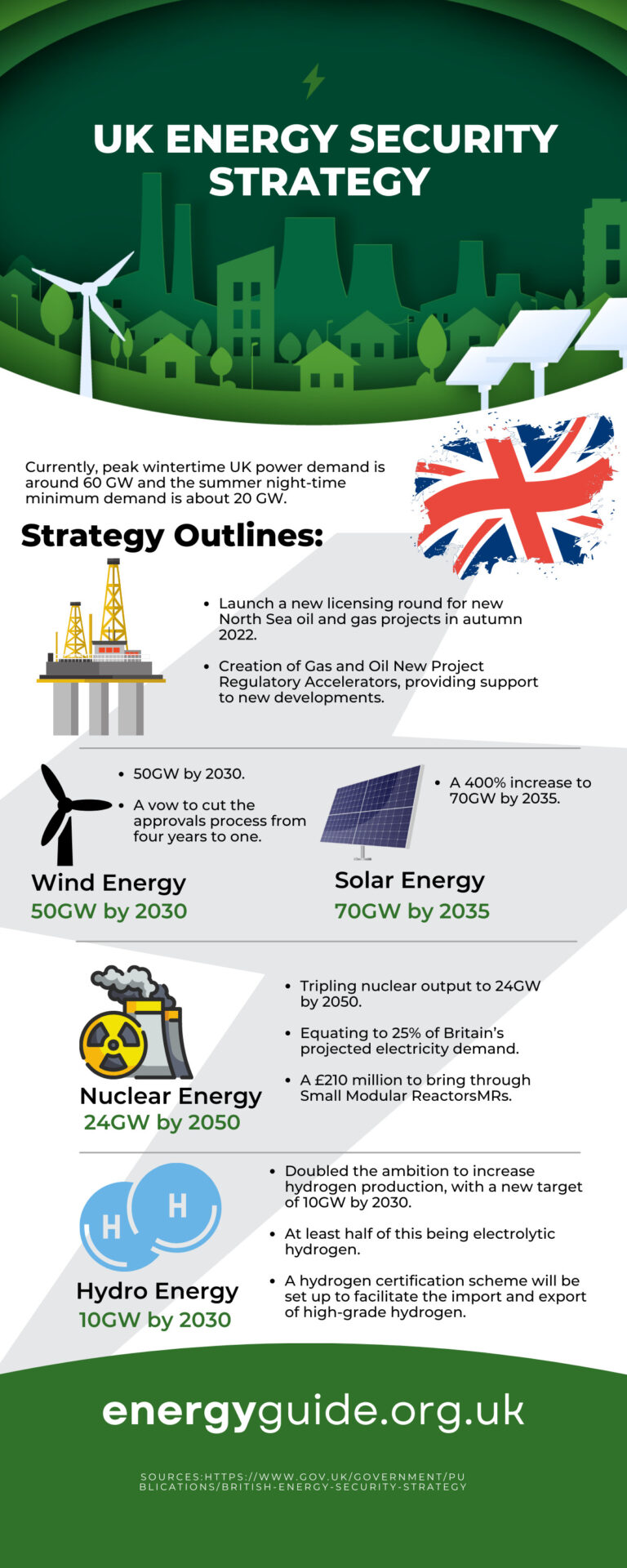The UK’s energy security strategy has received much more attention recently, largely due to the ongoing energy crisis, which unfortunately is expected to continue well into next year.
As you may be aware, the energy crisis began due to a post lockdown surge in demand, but was made far worse by the recent events in Eastern Europe.
In addition, the UK government has a legal obligation to become carbon neutral by 2050, which itself plays a fundamental role in how we plan our energy strategy going forward.
So what is UK government’s official energy security strategy? Here we explain everything that we currently know about the strategy, which was published on the 7th of April 2022.
UK Energy Security Strategy – What is It?
The official aim of the UK government’s energy security strategy was summarised simply as:
The key aim of the strategy is for the UK to achieve long-term independence from foreign energy sources and decarbonise the nation’s power supply.
The Energy Security strategy is very much in line with the European Commission’s latest release on the 8th March, which sought to outline Joint European Action for more secure, affordable and cleaner energy.
Energy Security Strategy Outline
So what does the strategy say exactly?
It breaks down each of the UK’s energy sectors and outlines exactly what the government aims to achieve for each:

Oil and Gas Strategy
The latest Energy Security strategy makes it very clear that the ultimate aim of the UK government is to achieve a carbon neutral or net zero economy.
However, it also makes it clear that in the short term both oil and gas security are essential to to take us through the low carbon transition.
As a result, the government plans to a new licensing round of exploratory gas and oil projects in the North Sea for Autumn 2022.
This will also be in conjunction with a new task force, the Gas and Oil New Project Regulatory Accelerators, providing support to new developments.
The argument for this is that it is far greener to source our own gas, than import it from other countries.
Wind Strategy
New offshore wind projects are going to be a major component of the UK’s energy security strategy.
The strategy aims to increase UK energy production via wind power to 50 gigawatt by the year 2030.
10% of these will be in the form of large floating turbines that can be located far off the coat of the UK.
The strategy also recognises the barrier of the long approval process, so promises to slash the process from four years to just one.
Nuclear Strategy UK
The UK’s energy strategy is very specific about the countries nuclear ambitions, pinning an ambitious aim of 24GW by 2050, making it responsible for around a quarter of Britain’s projected electricity demand.
The Government is committed to developing new nuclear power stations, aiming to take one project to final investment decision (FID) “this Parliament” (i.e., before January 2025 at the latest) and two projects to FID in the “next Parliament” (i.e., before January 2030 at the latest).
This Energy security strategy sets out the Government’s approach to the delivery of new nuclear power, including through the development of a robust regulatory framework and the investment of public funds in the delivery of new nuclear capacity. It also outlines progress to date and the next steps to be taken.
For example, this includes small modular reactors (SMRs). These advanced reactors are safer, more cost effective and, most importantly, generate clean energy.
Over the past few years, we’ve seen the first small modular reactor come online in the United States. We’ve also seen the first small modular reactor design certified by the Nuclear Regulatory Commission.
This in addition to the 100 million UK government investment to support the development of Sizewell C, and GBP 210 million to bring through Small Modular ReactorsMRs.
Hydrogen Energy Strategy
Hydrogen fuel is still in it’s early stages and is not yet ready for market, however, in the strategy document’s foreword, Boris Johnson makes it clear that hydrogen is “a low carbon super-fuel of the future”.
Scaling up the production of hydrogen is one of the key aims, with the official target being 10GW by 2030.
By 2025 the document makes clear that price-competitive hydrogen will be available by 2025 so that up to 1GW of electrolytic hydrogen is in construction or in operation by 2025.
UK Energy Security Strategy Final Thoughts
Although the energy strategy documentation is somewhat lacking detail and scope, what is clear is that there is a rough timeline for projects and low-carbon alternatives.
The UK government must also strike a balance between critics of net-zero, who claim the strategy is too much, too fast, as well as those who sit on the other side of the aisle and claim that the governments agenda does not go far enough.